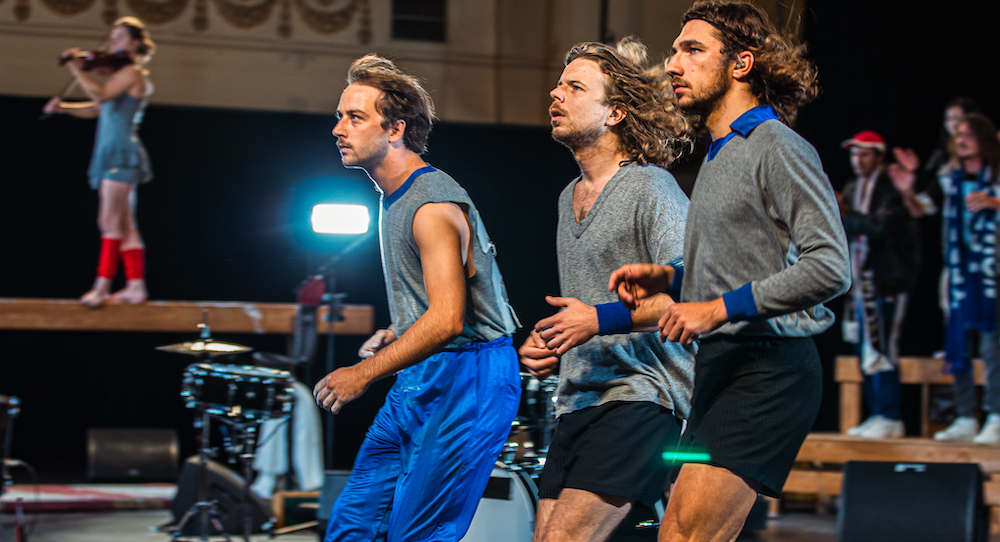Melbourne Town Hall, Melbourne.
13 June 2024.
It is a brave person who asks their audience to listen to one song over and over for an hour, whilst also confronting them with their own mortality.
In this instance, Belgian artist Miet Warlop gambled and won. One Song: Histoire(s) du Théâtre IV is an adrenalised melange of concert, carny and football final. At once boisterous and bizarre, it is an amped up meditation on the human condition. As such, it traces a path through the absurd and existential, with a distinctly Francophone bent recalling Camus, Beckett and Sartre. Along the way, it detours through Vaudeville, Brecht and Lepage — further spicing the mix with a ceremonial undertone reminiscent of cults and charismatics.
Meanwhile, all of the above is (somehow) infused into a frenzied hour of sweating physical theatre. One Song happens in an imagined arena – gym, pitch, stage – as the ‘band’ simultaneously moves through a rigorous workout and plays multiple versions of its single composition. They are ably supported by a cheerleader/ballerina and a clutch of scarf waving fans in the stands, and further urged on by an enthusiastic commentator. Throughout it all, a multi-coloured flag flies overhead, signalling something communal. Tribal. This could be sport, or maybe even an arts festival.
But look closer…the repetitions are not repetitions. The cycle repeats, yet breaks down. The breathless enthusiasm, the determination to exercise, to stay fit and young, grinds inexorably towards exhaustion and, finally, collapse. Here we are now, entertained but doomed. The colourful, virtuosic spectacle is a distraction, the cacophony we employ to obscure the insistent whisper of the inevitable. One Song is indeed theatre.
However, far from dwelling in hopelessness, Warlop’s multi-level creation is an exercise in sharing. We come together for the show, for rock bands and favourite teams, but also to navigate our suffering and grief. Even in the age of digital distance, we are never truly alone.
Considered simply as performance, it is high energy, comic and supple. Although the twelve performers and various props threaten to split our focus, the frenetic nature of the work rarely lurches into mess. If at times One Song resembles a riot, it is a clearly choreographed disturbance.
As for the song, it hovers somewhere in an art-rock, chamber-pop space, reminding you of bands like Stereolab and Arcade Fire, with a sprinkling of Max Richter and Philip Glass. What allows the ‘one song’ device to work is the way that it morphs, and the manner in which its performance is rooted to the athleticism of the players’ movement. In this way, it underscores the greater arc, travelling from muscular musicality to frazzled frailty. Like us, it falls apart.
The lyrics give us an early clue to Warlop’s thinking. The vocalist, performing on a treadmill, sings, ‘run for your life till you die.’
One Song scans as a modern day circus of the absurd. Highly intellectual, but with pratfalls. Personal, yet disguised as mob entertainment. True, you can become lost in a blizzard of concept, but you will likely be enthralled with the sheer audacity and elasticity of both the act and the idea. The standing ovation said as much.
By Paul Ransom of Dance Informa.















